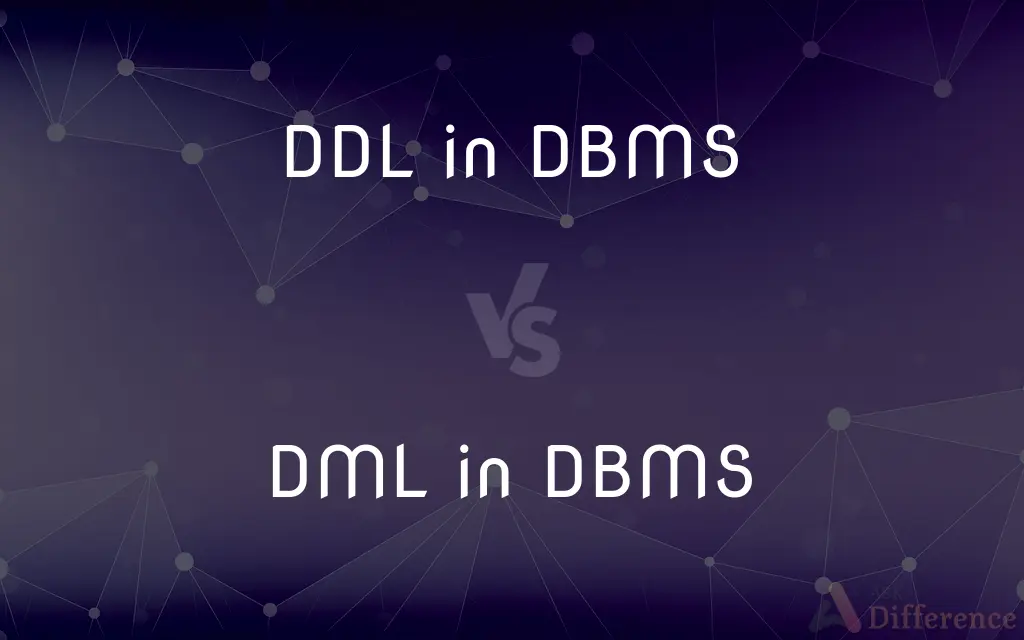DDL in DBMS vs. DML in DBMS — What's the Difference?
By Tayyaba Rehman — Published on January 1, 2024
DDL (Data Definition Language) in DBMS is used for defining and modifying database structure, while DML (Data Manipulation Language) is used for managing data within the database.

Difference Between DDL in DBMS and DML in DBMS
Table of Contents
ADVERTISEMENT
Key Differences
Purpose and Functionality: DDL (Data Definition Language) in a Database Management System (DBMS) is used to create, modify, and remove database objects like tables, indexes, and schemas. DML (Data Manipulation Language), on the other hand, is used to insert, update, delete, and retrieve data from these database objects.
Commands Used: Common DDL commands include CREATE, ALTER, and DROP, which are used to define and alter database structures. DML commands include SELECT, INSERT, UPDATE, and DELETE, which are used to manage and manipulate the data within the database.
Impact on Database: Operations performed using DDL directly change the schema and structure of the database. DML operations modify the data inside the database tables without affecting the database's structure.
Transaction Control: DDL commands often implicitly commit the transactions in most DBMS, meaning changes are auto-saved. DML operations can be rolled back or committed explicitly, giving more control over transaction management.
Usage in Database Operations: DDL is primarily used during the setup or modification of database structures. DML is used in regular database operations, like updating records, querying data, or deleting records.
ADVERTISEMENT
Comparison Chart
Primary Use
Defining/modifying database structure
Managing data within the database
Common Commands
CREATE, ALTER, DROP
SELECT, INSERT, UPDATE, DELETE
Impact
Changes database schema/structure
Modifies data, not structure
Transaction Control
Auto-commit changes
Allows explicit commit/rollback
Operational Context
Database setup and modification
Regular database operations
Compare with Definitions
DDL in DBMS
It includes commands like CREATE, ALTER, and DROP.
The ALTER TABLE command in DDL lets us add new columns to a table.
DML in DBMS
DML operations can be rolled back or committed.
If an UPDATE in DML goes wrong, we can roll back the transaction.
DDL in DBMS
DDL changes are often auto-committed.
When we DROP a table with DDL, the change is immediately saved.
DML in DBMS
DML is used for inserting, updating, and deleting data.
We use the INSERT INTO command in DML to add new records.
DDL in DBMS
Used for defining database schemas.
We define the initial database schema using DDL.
DML in DBMS
It includes commands like SELECT, INSERT, UPDATE, and DELETE.
The SELECT command in DML retrieves data from the database.
DDL in DBMS
DDL is used for creating and altering database structures.
We used the CREATE TABLE command in DDL to create a new table.
DML in DBMS
Used for daily data manipulation in databases.
DML is essential for everyday data operations in our system.
DDL in DBMS
Directly impacts the database structure.
DDL commands can drastically change the structure of our database.
DML in DBMS
Does not change the database structure.
DML modifies the data in tables without altering the table's structure.
Common Curiosities
What does DML stand for in DBMS?
DML stands for Data Manipulation Language in Database Management Systems.
Can DDL commands be rolled back?
In most DBMS, DDL commands cannot be rolled back as they are auto-committed.
Is DML used for creating a database?
No, DML is used for managing data within a database, not for creating it.
What is an example of a DDL operation?
Creating a new table using the CREATE TABLE command is an example of a DDL operation.
Can DML change the database schema?
No, DML does not change the schema but manipulates the data within the existing structure.
What does DDL stand for in DBMS?
DDL stands for Data Definition Language in Database Management Systems.
Is knowledge of DML important for database users?
Yes, understanding DML is crucial for anyone who needs to interact with and manage data in a database.
Is SQL a type of DDL?
SQL (Structured Query Language) includes DDL as a part of its syntax for defining database structures.
Can DML statements be automated?
Yes, DML statements can be automated through scripts and database programs.
Are DDL commands executed frequently?
DDL commands are less frequently executed as they are used for setting up and modifying database structures.
Do DDL commands affect data integrity?
DDL commands can affect data integrity if they modify structures like tables where data is stored.
What is an example of a DML operation?
Inserting data into a table using the INSERT INTO command is an example of a DML operation.
How does one learn DDL and DML in DBMS?
Learning DDL and DML typically involves studying SQL and practicing with a database system.
Are indexes created using DDL?
Yes, indexes are created using DDL commands like CREATE INDEX.
What happens if a DML statement fails?
If a DML statement fails, it can be rolled back to revert the changes, provided the transaction isn't committed.
Share Your Discovery

Previous Comparison
Estuvo vs. Estaba
Next Comparison
Corals vs. SpongesAuthor Spotlight
Written by
Tayyaba RehmanTayyaba Rehman is a distinguished writer, currently serving as a primary contributor to askdifference.com. As a researcher in semantics and etymology, Tayyaba's passion for the complexity of languages and their distinctions has found a perfect home on the platform. Tayyaba delves into the intricacies of language, distinguishing between commonly confused words and phrases, thereby providing clarity for readers worldwide.
















































